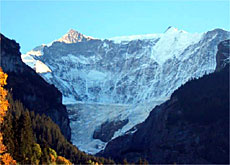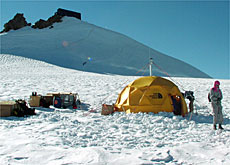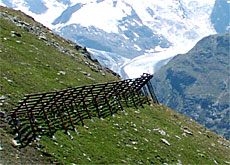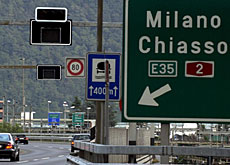Glaciers’ retreat causes alarm

The world's glaciers, including those in Switzerland, are melting at an alarming rate, says the WWF.
If governments don’t take urgent action, the organisation warns, billions of people could face severe water shortages.
The WWF released its report on climate change and global glacier decline ahead of the ninth Conference of the Parties to the United Nations Framework Convention for Climate Change, taking place in Milan next week.
The organisation warns that if global temperatures rise by four degrees over this century, most of the world’s glaciers will disappear.
As a result billions of people will be without water, as glaciers contain 70 per cent of the world’s freshwater reserves. In addition, rising sea levels will destroy coastal communities.
Europe’s water tower
“Switzerland is often called the water tower of Europe,” said Martin Grosjean, a glaciologist at the University of Bern. “Because of all the water stored in the glaciers.”
“Glaciers are one indicator of the water cycle,” he told swissinfo. “They show that the water available during the seasons is changing rapidly, and the question is how can society cope with long term water shortages.”
Switzerland’s glaciers have been retreating for 150 years, since the end of the “little ice age” in the mid 19th century. Since then, over 100 alpine glaciers have disappeared altogether.
“But after 1970 we see that for all glaciers the retreat is accelerated,” said Grosjean. “It’s faster than anything we have seen in the past 500 years.”
Were the glaciers to disappear altogether, summer water levels in Europe’s rivers would drop substantially; in June, July and August over half the water in the Rhine is glacial melt water.
Falling river levels would threaten crop irrigation, and obstruct freight traffic on Europe’s waterways.
Global warming
Environmental specialists are now sure that global warming is to blame for the glaciers’ retreat.
“We are convinced that the climate is changing,” said Patrick Hofstetter, a specialist on climate change with the WWF.
“The temperature is rising even more in the Alps than in other regions,” Hofstetter told swissinfo. “So they are especially vulnerable.”
The WWF is using the example of the melting glaciers in its latest campaign to persuade the Swiss government to introduce new laws restricting carbon dioxide emissions, which are believed by experts to contribute to global warming.
“The glaciers are the most visible indicator of what is happening,” Hofstetter explained. “But there are other potentially very dangerous things that we don’t see so easily.
“The permafrost is thawing out too in the Alps – this could lead to mud and rock slides. It’s possible that some of our alpine valleys will become uninhabitable.”
From ice to rock
A visit to the lower Grindelwald glacier is one of the best demonstrations of how the alpine geology has changed over the years.
In the 18th and 19th centuries the glacier was a tourist attraction simply because of its dramatic size; it stretched almost to the village of Grindelwald itself.
“It was even a source of business,” said Martin Grosjean. “The ice was cut into blocks and exported to Paris for people to put in their cocktails.”
Now, that once impressive stretch of ice is rock with new tree growth on it, and the glacier has retreated several hundred metres further up the mountain.
It’s a change that has been noticed by local mountain guides like Hans Lohner, who has been taking hikers on glacier walks for 40 years.
“It used to be much easier to get to the glacier,” Lohner told swissinfo. “Twenty years ago we could take people up there much more easily, but now it has retreated so much we can only really go with experienced climbers.”
Lohner is especially concerned about the effect on the glacier of the high temperatures witnessed this summer.
“Normally even in high summer if you went up to 3,000 metres everything would be frozen in the morning,” he explained. “But not this summer; it didn’t even freeze at night, so the glacier was melting 24 hours a day.”
Change or risk
Climatologists regard the changes in the glaciers as a key warning sign for climate change, and say we can no longer afford to ignore the message.
“We are going to have to think much more about whether we need our cars or not, about where we build our houses, and so on,” said Hofstettler. “But in the long term, what we are going to have to do is shift away from using fossil fuels completely.”
“Scientists can tell us global warming is happening,” added Grosjean. “But finally it’s a decision society has to take.
“How much are we willing to pay in terms of damage to us or to the environment? How big is the risk we are willing to take?”
swissinfo, Imogen Foulkes
Over 100 glaciers have disappeared in Switzerland since 1850.
Their shrinkage has accelerated rapidly since 1970.
Between four and six per cent of Switzerland is covered by permafrost.
Climatologists regard the changes in the glaciers as a key indicator of global warming.

In compliance with the JTI standards
More: SWI swissinfo.ch certified by the Journalism Trust Initiative



You can find an overview of ongoing debates with our journalists here. Please join us!
If you want to start a conversation about a topic raised in this article or want to report factual errors, email us at english@swissinfo.ch.